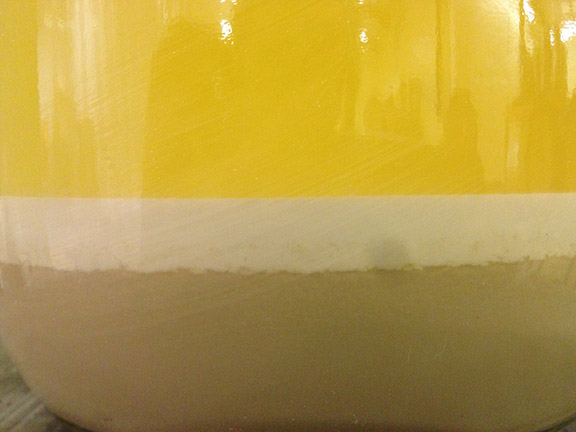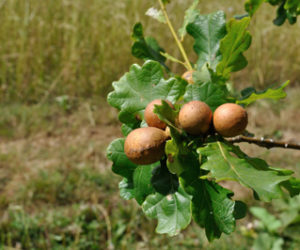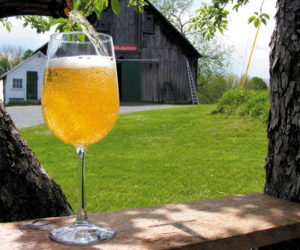While this issue’s topic is really more of an intermediate to advanced concept and technique in winemaking, there is no reason beginning winemakers should not be thinking about these techniques as they advance. Let’s start with the basic idea of what lees are, the process of sur lie aging, and how bâttonage fits into the picture.
Understanding Lees
In the broadest sense of the term, lees are what fall to the bottom of a fermenting or aging vat of wine. Winemakers generally will split lees into two classes, each with their own set of characteristics. Gross lees are generally the first to precipitate to the bottom of your fermenter, usually within the first 24 hours after the grapes are pressed. These include grape skins, MOG (material other than grapes), seeds, stems, dead yeast, and tartrates, among other things. It is preferred that gross lees are removed after they have settled since they can contribute off-flavors.
Fine lees take longer to settle and they mainly consist of dead yeast cells. These take days to settle, even weeks, and unlike gross lees, can greatly enhance the body of a wine. This is why some of the great wines of the world, e.g., Champagne, are aged on the fine lees. While it is traditional to age some wine on the lees, not all wine is meant to be aged on them. So let’s take a spin through why you may want to use them.
Making the Most of Lees
So what makes fine lees so special to winemakers? Well we can’t talk about them without understanding autolysis and mannoproteins. The term autolysis refers to the breakdown of the dead yeast cells that have precipitated out of the wine. While this decomposition may seem like something winemakers would like to avoid, the dead yeast release a class of compounds from the cell wall known as mannoproteins. These compounds are a natural enhancer to the mouthfeel and body of a wine.

Mannoproteins will also interact with tannins, reducing the astringency and harshness that can be associated with excess tannins. The benefits of mannoproteins doesn’t stop there . . . they also can stabilize a red wine’s color, inhibit tartrate crystallization, and reduce both oxidation and protein haze. Winemakers can find products that will provide them via inactivated yeast like Enartis Pro Uno.
So while winemakers often want to remove the gross lees, as we just found out, aging wine on the fine lees can have many benefits. The only downside with aging on fine lees can be in the extreme example that they completely run out of oxygen in solution and start to produce hydrogen sulfide. This can easily be taken care of by racking wine, which will both remove the wine from the lees and reintroduce a little oxygen to solution.
How To Age on Fine Lees
First off, winemakers using kits or juices are at an advantage here since most will contain very limited amounts of gross lees. The fine lees will be the vast majority of the lees that settle to the bottom of their fermenters. Fresh grapes on the other hand will need an extra step to separate the two forms of lees. Since gross lees will settle within roughly 24 hours and fine lees take longer, we can use the physical discrepancy to our advantage. After pressing the grapes, winemakers can allow the gross lees to settle for 24 hours, then rack the wine off the gross lees. Then most of the fine lees will slowly settle to the bottom over the course of the next several days.
Sur Lie Aging and Bâttonage
Sur lie aging simply means that the winemaker has aged their wine on the lees. An important element to sur lie aging is the bâttonage process. This is simply a French term for stirring the wine and in doing so, mixing the lees back into solution. Why would winemakers want to do this? There are several reasons. First is that it can speed up the autolysis process and the release of the mannoproteins into your wine. Second, if your wine is going through the malolactic fermentation process, the stirred lees can better provide nutrients to the bacteria as well as scavenge oxygen from solution, which the bacteria likes. Finally, the bâttonage process prevents the yeast from compacting on the floor of your fermenter, which can cause problems such as creating hydrogen sulfide gas.
Just be sure to be very gentle while stirring since you want to minimize the introduction of oxygen. Carboys and demijohns can simply be rolled around on their rim so you don’t actually need to even open the fermenter. For larger tanks or when aging in barrels, there are special tools winemakers can utilize for the stirring process.
So how often do you want to perform the bâttonage process on your wine when aging on the lees? While there is no hard and fast rule, the general answer from professional winemakers is every 2–4 weeks. If all you’re doing is rolling the carboy around, then every two weeks seems reasonable. If you have to open your fermenter and stir, you may want to do it every four weeks to minimize oxidation issues.
For a deeper dive into the science and different stylistic approaches to lees and sur lie aging, I recommend: https://winemakermag.com/technique/lees-and-you-dead-yeast-can-be-your-friend






